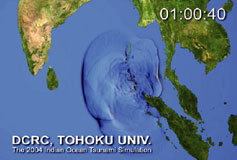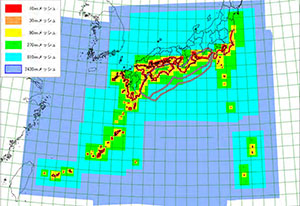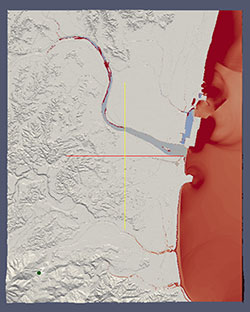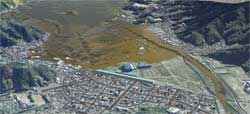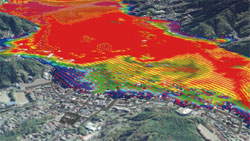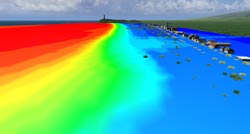The tsunami solver is based on the solver provided by Prof. Fumihiko Imamura
of Tohoku University. This has the following features.
1. Propagation calculation of tsunami based on the shallow water long
wave theory
2. Analysis performed in a large-scale range via nesting method
3. Batch simulation from the tsunami generation to the propagation of
an earthquake
4. The detailed representation of the coast area including the bank and river
1. Propagation calculation of tsunami based on the shallow water long wave
theory
This solver is based on the theory called "shallow water long wave".
Compared to deep-sea, the tsunami whose water depth is below 50m shows
the characteristic behaviors, in which the wave height becomes higher etc.
The shallow water long wave theory allows to represent the tsunami behavior
along the coast in detail by taking into consideration a unique phenomenon
for the tsunami propagation in a shallow area. The equation based on this
shallow water long wave theory is calculated via finite difference method
(FEM) on an orthogonal grid mesh.
2. Analysis performed in a large-scale range via nesting method
The propagation of tsunami sometimes reaches more than 100 km from the
tsunami origin to the Japanese coast. However in case of calculating 100km
square mesh, if selecting a small sized mesh to do a detailed analysis,
simulation would be run at a distant time due to the vast number of mesh.
On the other hand, selecting the large mesh can make the amount of calculation
small and also make the simulation time shorter but make the detailed analysis
more difficult.
The solver this time adopted the nesting method. Nesting method allows
you to make the size of mesh in the coastal area where the damage caused
by tsunami is expected to be huge more smaller, on the other hand, to make
the size of mesh of the open sea more bigger and then let the small size
mesh in the bigger sized mesh. Therefore this method makes it possible
to run detail tsunami simulation by using the small size mesh in the coastal
area without making the analysis region smaller. This also can shorten
calculation time.
3. Batch simulation from the tsunami generation to the propagation of an
earthquake
This solver allows you to calculate the initial wave height of tsunami
from the faulting which causes an earthquake and calculate the propagation
of tsunami based on the initial wave height.
Therefore the phenomenon of tsunami can be represented in more realistic
way than setting the initial wave height which is virtual.
4. The detailed representation of the coast area including the bank and
river
In this solver, the detailed simulation for the coastal area can be run
by setting with or without a bank. Moreover taking into consideration a
river can make it possible to represent river-runup of tsunami.
|

